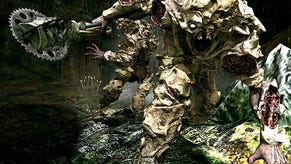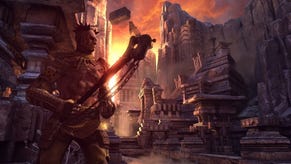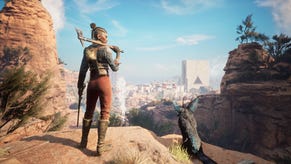Rage
The first two hours.
Character design and animation is rather less futuristic – it's perfectly serviceable, but those hoping for the subtlety and storytelling guile of an L.A. Noire or even Uncharted will probably find the regular sequences where you stand face to face with a sheriff or local tradesman listening to a monologue rather old-fashioned.
The rigidity of conversations and transparency of the quest structure are just as apparent in something like Fallout, of course, but the compensations there are an excitingly unpredictable ecosystem and the way you can feel the cumulative weight of your decision-making. Rage can't offer those things.
It enjoys greater success blending the driving elements into exploration and competition. After a few starter missions, Hagar's mechanic lets you loose on a proper dune buggy, and once you reach Wellspring you can enter races to earn weapons and upgrades. Decked out in a new livery – an id logo, obviously – and sporting a machinegun, you terrorise canyon floors and basins between missions, destroying bandit buggies in exchange for rewards from local merchants.
Buggies and ATVs are heavy but responsive, and the auto-aiming machineguns are a doddle to fire as you joust with and circle other vehicles. Early races are less exciting, but if the Smuggler's Run-style objective-chasing gametypes we've seen for multiplayer also feature in the campaign, then we could be in for something a lot more complementary than just a colourful diversion. Vehicular combat may not be id's heritage, but its gameplay principles are certainly transferrable.
The last I get to play of Rage before I'm booted out to make way for another eager customer is actually a level I've seen before – a prison break at a dilapidated Authority detention centre, around 6-8 hours into the game. By this stage your arsenal and inventory are overflowing with ammo types and blueprints, and for somebody who's spent the first two hours of the campaign scratching toys together and cherishing every Fatboy pistol shell, it's a giddy delight.
Up against Authority forces with translucent energy shields, automated sentry guns tied in to portable generators and turret guns, I get to bring electric bolts, pulse shells, little RC car bombs and more exotic weaponry. It's a fitting send-off and whets the appetite for more blueprints, more ammo types, and more Rage.
There are plenty of old beats here – holding your ground while an ally hacks a wall terminal, shooting the turret gunner and then taking over his position – but if from time to time Rage feels like a bit of a dinosaur, at least it's a roaring, stomping Tyrannosaurus Rex where it really matters.
The Sisyphean grind of Doom 3 has been replaced by a post-apocalyptic, quasi-openworld crust, and within that the immediacy of control, flying body parts and dense, corkscrewing level design – corridors galore – have been embellished with smart combat modifiers and, of course, some of the fastest, most detailed graphics you've ever seen, flooding out of your preferred buffer at 60 frames per second.
Is it a proper id Software game? I guess we'll know for sure When It's Done. I'll be queuing up to make sure.























.png?width=291&height=164&fit=crop&quality=80&format=jpg&auto=webp)


